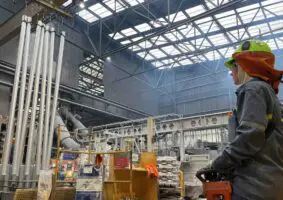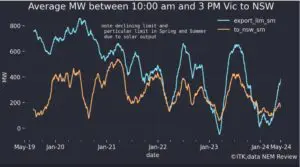Thank goodness for the electricity price
If you are an investor at first glance it was really only the strong balance sheet (Mr Redman’s prior responsibility) and wholesale electricity and gas prices that would give you any satisfaction in yesterday’s result. On the more gloomy side:
- Gas and electricity volumes were down.
- AGL lost control of the wholesale gas market a couple of years ago when it refused to contract sufficient supply to maintain its prior position as the preeminent middleman. That position has been ceded to Origin Energy. AGL has extensive pipeline rental fixed costs and less volume to put through them. At the same time the high price of gas makes building a gas generation portfolio a tough business.
- High prices tend to lower volumes in every market including electricity

- Operating costs including gas and coal costs increased
- AGL halved its estimate of cost out achievable benefits from $120 m per year to $60 m per year. This comes as no surprise to me, and probably not much of a one to the market. Still if you capitalise that reduction at 8x its $480 m pretax reduction in value to investors.
- AGL will move from fully contracted for coal to requiring new contracts for 10-20% of its volume over the next couple of years at prices substantially higher than contract prices, like double.

- Sustaining (maintenance) capex in coal generation plants is running at $330 m per year about half or more of thermal generation profits and shows no real sign of letting up. That’s capex around $11/MWh of metered output.

The more I think about this number the more I think about it. It takes a lot of capex to keep the clunkers going. If electricity prices do decline, as most expect, cash flow will become an issue, and AGL has the lowest cost coal assets South of the Queensland border. You can bet not too much of that capex is going to Liddell.
Australia cannot afford to put its future on these ancient, increasingly unreliable assets. And the solution is surely not the half-baked, entirely insufficient plan of Angus Taylor. Where is Mr Taylor’s support of the ESB? Where is his government’s view and response to the Integrated System Plan? It’s impossible to take him seriously. Perhaps one should, but it’s impossible. Off the air.
- Hedge contracts were out of the money requiring higher margins, no surprise there but as a result operating cash flows were well down on PCP. This should reverse if and when electricity pool prices fall.
- AGL noted, that although guidance was unchanged, it expected a weaker second half , than the first half driven by lower gas volumes, margin compression and price cuts in Victoria.There doesn’t appear to be any change in near term consensus estimates following yesterday’s result. Not surprising since the mid point of guidance remains what management believe is what will be reported.
The way forward?
In our view new CEO, Brett Redman, has yet to articulate a strategy that is going to excite investors. To be fair, the previous CEO, Andy Vesey, happened to get the job just when pool prices went through the roof. Basically all Vesey had to do was count the profits. And he mostly did that from overseas.
Not only that, AGL’s report makes it clear that when Andy Vesey was CEO, AGL did not collect employee engagement data. This is fairly unsatisfactory and perhaps has more to do with Mr Vesey’s departure than was apparent at the time.
It’s a much tougher job for AGL management from here. Still the market doesn’t care about the degree of difficulty, it cares only about the scoreboard.
Notwithstanding high pool prices, AGL remains Australia’s highest carbon emitter, but also its most important supplier of electricity.
AGL’s comparative advantage in electricity retail is the size of its customer base and the size of its load. The customer base drives relatively low customer care costs and electricity hedging costs but also brings onerous reporting, social safety net and other “big business” issues.
So far, none of the large electricity retailers have found a way to earn sustainable profits from rooftop solar. Solar installation profits are modest relative to AGL’s main business and will be capitalized at a low multiple by investors.
Gas importing will be seen as marginal by investors, perhaps necessary but a “grudge” business.
AGL can compete in the utility wind and solar business, not on construction costs or site development but it can sell the output. However to go into that big-time will cannibalise its coal generation profits. This is the classic problem incumbents face from industry disruption.
On the other hand if AGL doesn’t offer competitive wholesale prices to its business customers it, and the other majors, will lose market share into the corporate PPA business.
All of this points to AGl, and for that matter ORG and Energy Australia’s natural market being the dispatchable power segment. Dispatchable power can also be thought of as “firming power”. It can include large scale projects, demand response and household batteries.
Eventually one of the big gentailers will work out that this is a real opportunity. Not something to fiddle round the edges of but something to go hard at and earn the first mover reward (or arrow in the back).











